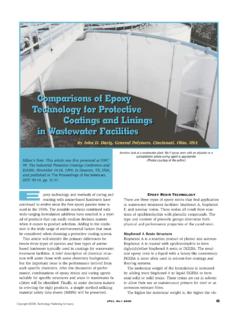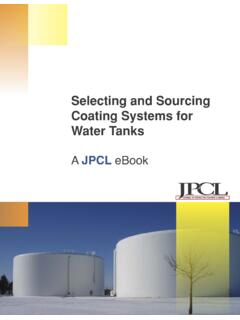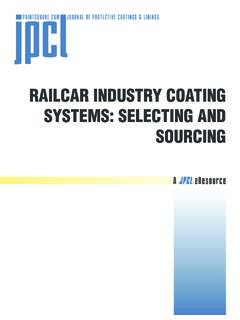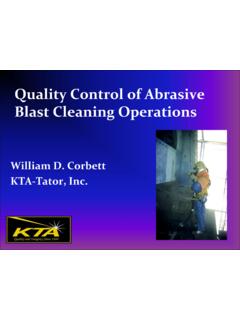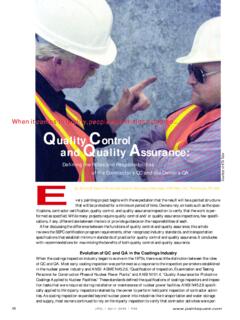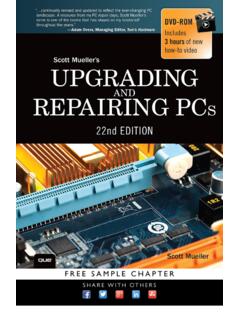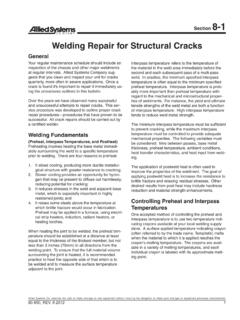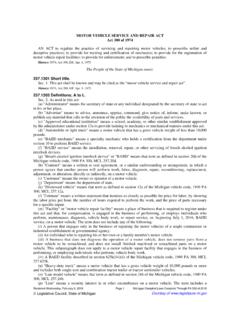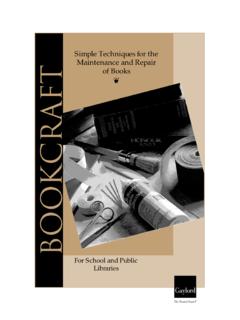Transcription of Repairing Untopcoated IOZ Coatings - paintsquare.com
1 Copyright 1998, Technology Publishing CompanyJPCL/ NOVEMBER 1998 11 AnswerSinisa Ozanic,IMC Engineering ,Genoa, Italy:Zinc Coatings are widely used be-cause of their versatility, resistanceto corrosion and abrasion, and easeof zinccoatings (IOZ)are particularlyattractive tomany , inspite of theirproven resistance to adverse weath-er conditions and to wear, mainte-nance is imperative for structurescoated with these long exposure, the mostcommon failure observed on IOZ ispinpoint rusting. It develops slowlybut can spread to a large area if notstopped. Pinpoint rusting may bethe result of low dry film thickness(dft) or even factors may contribute tothis problem. First of all, IOZ is usu-ally applied in a single coat at aDFT of 50 to 100 m (2 to 4 mils),which allows no margin for spray-ing mistakes. In addition, the coat-ing s gray color may be difficult todistinguish from freshly blast-cleaned steel, especially in poorlighting.
2 Also, the sprayed passesmay overlap differ for new and agedcoatings of of holidays or skips in anew coating usually involve smallareas that are prepared by powertool cleaning. Paint manufacturersoften recommend power tool clean-ing to a thorough (St 2) or very thor-ough (St 3) standard in accordancewith ISO 8501-1 (Preparation ofSteel Substrates Before Applicationof Paints and Related Products Visu-al Assessment of Surface Cleanli-ness Part 1:Rust Gradesand Prepara-tion Grades ofUncoated SteelSubstrates andof Steel Sub-strates AfterOverall Removal of Previous Coat-ings), or in accordance with SSPC-SP3 (Power Tool Cleaning). Surface preparation should be fol-lowed by brush (not roller!) appli-cation of an IOZ repair coating to aspecified DFT. However, since IOZsdo not form films as well as organicbinders, their use should be limitedto small zones.
3 Attention must begiven to proper removal of dust, toproper overlapping onto the exist-ing coating, and, of course, to envi-ronmental conditions during appli-cation. The situation is different whentreating aged Coatings . During yearsof service, the porous IOZ coatingcan become sealed as zinc particlesare encapsulated by oxides and car-bonate reaction products. This con-dition, combined with a high sur-face density, can cause adhesionproblems between original and re-pair Coatings . Therefore, it is neces-sary to expose the zinc in lower lay-continuedRepairing Untopcoated IOZ CoatingsPROBLEM SOLVING FORUMQ uestionWhat is the best procedure for touching up rusted, Untopcoated inorganic zinc-rich Coatings ?Copyright 1998, Technology Publishing CompanyJPCL/ NOVEMBER 1998 13 PROBLEM SOLVING FORUMers of the original coating so it canreact with the repair coating. This isdone by abrasive blasting, whichalso removes corrosion and pro-vides a proper profile for good ad-hesion.
4 Many people think SSPC-SP7 (brush-off blast cleaning) is suffi-cient. It is adequate for featheringedges, but it is not thoroughenough to remove rust. Hence,SSPC-SP 6 (commercial blast clean-ing, which is the equivalent of Sa2), in my opinion, is the open abrasive blastingis not possible or is too blasting could be used, butits production rate on structural steelcan be low. Therefore, it is better tolimit its use to small areas. Discsanding also could be used for limit-ed areas. In that case, selection ofproper disc grain size is important toavoid polishing. Reduction of sur-face roughness while disc sanding isunavoidable, so it is good to treatthe area with a needle gun withenough force to add some rough-ness but not enough to gouge thesurface. A needle gun also is a goodtool for cleaning corners, angles,bolts, rivets, etc., but slowness ofthis operation is a of a new IOZ coatingmust be done with care by skilledpainters.
5 The recommended methodis spraying with a nozzle fan angleof not more than 30 degrees. Goodworkmanship is essential to providethe required DFT on cleaned steel,proper coverage on feathered areas,and no overlapping on areas are particularlysensitive, since excessive thicknessthere can cause the coating to crack,while overlapping onto unpreparedsurfaces can lead to quick done well, however, touchingup an IOZ coating is always a goodinvestment that can provide excel-lent performance for many years. Keijman,Ameron International,Geldermalsen, The Netherlands:The procedure for touching up rust-ed, Untopcoated inorganic zinc-richcoatings depends on various factorsin relation to service conditions andthe progress of the rust or corrosionof the steel LiningsMost Untopcoated inorganic zinc-rich Coatings or zinc silicates areused as tank with rust all over shouldbe blast cleaned to Sa 2 1/2 Sa 3continued Copyright 1998, Technology Publishing Company(SSPC-SP 10, Near-White, to SSPC-SP 5, White Metal) followed by ap-plication of a full coat of a zinc sili-cate at the original dry filmthickness.
6 The same procedure is preferredfor localized repairs of isolated rustspots. When blast cleaning is notfeasible, power tool cleaning with aneedle gun, disc sander, etc., fol-lowed by application of a zinc sili-cate coating, is an alternative. It should be noted, however, thatcoating performance is proportionalto the quality of surface zinc silicates arerecommended for maintenance andrepair of zinc silicate tank zinc silicates are lesstolerant on existing inorganic zinc-rich Coatings , particularly when residues of cargoes are stillpresent in the pores of the old TemperaturesUntopcoated zinc silicates also areused to protect steel at elevated tem-peratures. The same repair proce-dures as for tank linings are ExposureSingle coats of Untopcoated inorgan-ic zinc-rich Coatings also are used toprotect steel structures exposed toatmospheric environments at ambi-ent a major part of the structureis corroded, blast cleaning to Sa 21/2 (SSPC-SP 10) followed by appli-cation of a full coat of a zinc silicatecoating is recommended.
7 Whenblast cleaning is not possible, alter-natives include power tool cleaningor high-pressure water washing fol-lowed by application of a surface-tolerant repair of localized rust spots,power tool cleaning, such as discsanding, followed by application ofa zinc silicate is recommended. Asan alternative, a zinc epoxy can beused, preferably with an additionalepoxy topcoat. Also, surface-tolerantepoxies can be used to repair me-chanically cleaned local damage ofzinc silicate M. Tolotto,Technical Director,BOAT ,Genoa, Italy:Zinc-rich paints differ from othercoatings used for steel action is not limited to the for-mation of a barrier between the sur-face and the effectiveness of other coatingtypes ceases where the paint film isdamaged. As a result, underfilm cor-PROBLEM SOLVING FORUM14 NOVEMBER 1998 / JPCLPSF continued on page 116 This blank page has been inserted here so that two page spreads can be viewed side-by-side in Adobe of Protective Coatings & LiningsCopyright 1998, Technology Publishing Companyrosion may occur.
8 However, wherea zinc-rich paint film is damaged,the uncoated area may continue tobe protected if the damage is notwide, and the edges of the sur-rounding film may continue to beprotected against underfilm is because the electrochemi-cal potential of zinc is lower thanthat of steel. When these two metalsare connected in an electrolytic solu-tion, the zinc protects the steel bythe cathodic protection the film is damaged, the zincon the surrounding area sacrifices it-self to protect the uncoated area forsome time and prevents the progres-sion of underfilm corrosion by pro-ducing reaction zinc-rich primer requires correctformulation, of course, plus veryclose and widespread contact withthe painted surface. Blast cleaning isthe only suitable surface preparationmethod for this purpose. Inorganic zinc primers can beclassified into two types: water-borne (based on lithium and potassi-um silicates) and solvent-borne(based on partially hydrolyzed ethylsilicate).
9 These Coatings are widely used as a) a single coat for protection oftanks for chemical products (usuallysolvents); b) a primer for long-lasting paintsystems or for Untopcoated systems; or c) a shop primer. In the first case, the water-bornetype is preferred. In the other twocases, the solvent type is PS Guide , Guide toZinc-Rich Coating Systems1, says un-topcoated IOZ primers may be suit-able for use in the following envi-ronments: 1A interior, normally dry; 1B exterior, normally dry; 2A frequently wet, fresh water; 2B frequently wet, salt water; 3B atmospheric chemical expo-sure (pH 5 to 10); and 3D chemical exposure, solvents. Coming to the question after thislong introduction, I would cite twocompletely different IThe coating is still intact and rustinghas occurred where the coating hassuffered damages. The main pur-pose of touching up an inorganiczinc-rich primer is to repair the filmintegrity by maintaining its specificelectrochemical characteristics.
10 How-ever, it is necessary to distinguishamong different possible uses of thecoating, as ) As a single coat for the protec-tion of tanks for chemical products(3D) This use requires maximumprotection, and it is necessary to re-pair the continuity of film character-istics everywhere. Vacuum blastingor, for minor touch-up areas, needlegun preparation can be used. Appli-cation of the same inorganic zinc-rich paint must be done carefully,with particular attention to overlap-ping ) As a coating for use in environ-ments 1A, 1B, 2A, 2B, or 3B Theabove-mentioned procedure couldbe used here as well, because it pro-vides good protection. However, itis expensive because of the surfacepreparation methods involved andthe skill of the operator required forapplying the coating. If that proce-dure is not feasible, mechanicalpreparation according to SSPC SP 11(Power Tool Cleaning to Bare Metal)or SSPC SP 3 (Power Tool Cleaning)can be used, feathering the transi-tion from thick film touch-up areasto bare steel by grinding.

